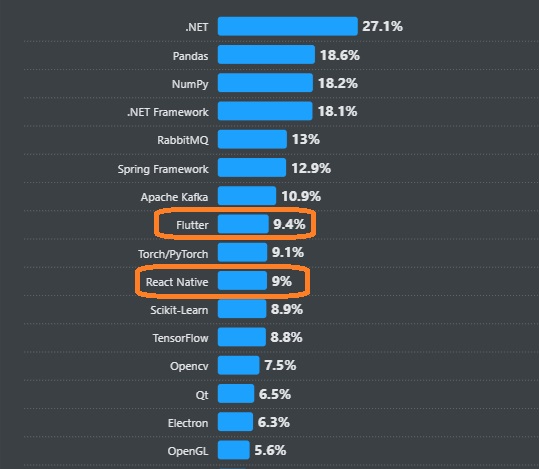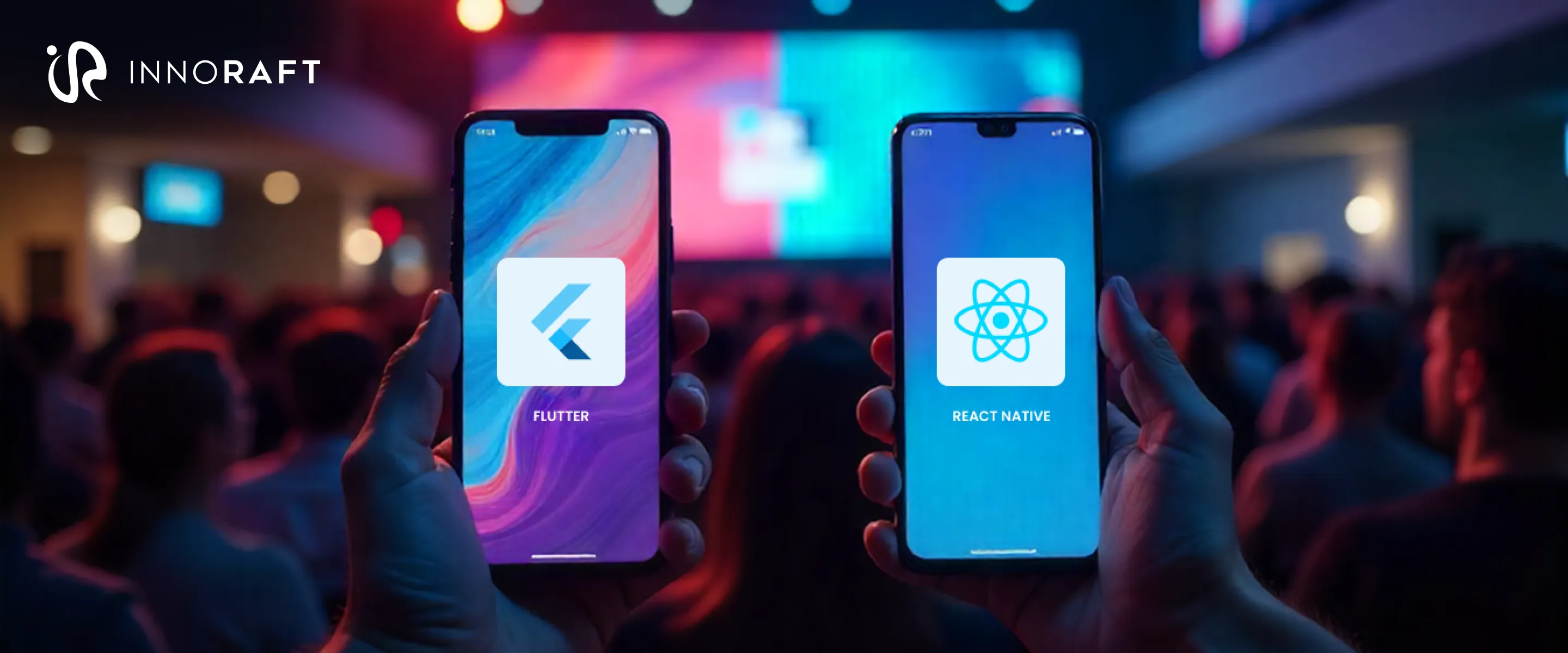If you are building a cross-platform mobile app today, two big players are vying for your focus. Flutter and React Native are cross-platform development platforms that allow developers to create apps that can function equally well on numerous platforms, such as iOS, Android, and the web, using a single codebase. Though they are cross-platform development platforms, they are very different in terms of base technology, architecture, and features.
Flutter thrives in speed, UI consistency, and animation, making it perfect for visually sophisticated apps. React Native benefits teams with JavaScript experience and apps requiring platform-specific behaviors. Your choice should be based on your team's expertise, performance needs, and platform UI consistency.
Brief Overview of Flutter vs React Native
Flutter is a free UI library, designed by Google in 2017, from which cross-platform applications were created for mobile, Windows, macOS, Linux, and web devices. Through the use of Dart, Flutter was created. Top companies like Philips Hue, Hamilton, and many more were created in Flutter. With every release, Google also updates Flutter to make it even better.
Facebook developed React Native in 2015. It is an open-source framework created in JavaScript. It uses the same codebase to generate cross-platform apps, removing the need to compile additional technologies for mobile app development services. Skype, Instagram, Uber Eats, and other apps depend on React Native for development.
Why is Choosing the Right Framework A Game-Changer?
Your framework impacts performance, scalability, maintenance, pricing, and the speed at which you can create and deploy your application. Proper selection will streamline everything, provide an excellent user experience, and lower long-term expenditures. Let's examine how to select the best cross-platform app development solution for your project.
Businesses seek frameworks that shorten development time and provide consistent user experiences across numerous platforms. The decision between React Native and Flutter will significantly affect the performance, the speed at which the application is developed, and its long-term ability to be maintained. Both platforms have gone through some significant modifications, hosting several new features and improvements. As a startup developing an MVP or an organization needing a high-performance application, the recognition of both frameworks' favorable aspects will be essential for application development.
Flutter and React Native remain almost closely matched in popularity, with Flutter having a slight edge of less than half a percentage point.

Source: Stack Overflow
The difference is modest, demonstrating how both frameworks have developed into reliable options for cross-platform app development. The selection is frequently based on specific project requirements, developer experience, and organizational goals.
Performance: Speed and Efficacy
Flutter's Skia rendering engine, which creates graphics directly onto the canvas, is especially impressive. This cuts out platform-native widgets and provides developers with complete control over rendering. With Ahead-of-Time (AOT) compilation, Flutter compiles Dart code to native machine code, with faster app startup and consistently smooth animation as a result.
React Native has advanced with the Hermes JavaScript engine, reducing reliance on the JavaScript bridge. Hermes converts JavaScript to bytecode, which improves startup speeds and memory utilization. While it performs admirably in most situations, apps with complex animations may sometimes lack it due to indirect rendering. Also, React Native's Concurrent Rendering functionality enables incremental rendering of UI components. This ensures better animations and lowers UI delay, even in complicated applications.
Development Languages and Ecosystems
With the extensive utilization of Dart in Flutter, it has evolved into a developer-friendly language through which developers can write highly optimized, bug-free code. It is a fast-increasing ecosystem of Dart concerning its integration with many more tools of Google, like Firebase or Google Cloud.
The JavaScript/TypeScript community is among the globe's largest and most vibrant communities of developers, and React Native benefits from being a part of it. JavaScript's versatility and familiarity make developers find it easy to transition to React Native. TypeScript reduces errors while improving code maintainability.
UI/UX Improvement
Flutter's architecture is based on widgets, including buttons for layout components. This gives complete UI control, pixel-perfect visuals, and native platform performance. Flutter's Cupertino and Material Design widgets support provides that applications appear and feel native on Android and iOS.
The fundamental basis for React Native will be the UI components, which are excellent in their look and feel on the given platform. As much as this will have specific layouts for each platform, incompatibility can also arise between Android app development services and iOS app development services. React Native uses third-party libraries, such as React Native Paper, to extend its UI functions further.
Cross-Platform Assistance: Mobile, Web, and Desktop
Flutter provides a "write once, run anywhere" environment. The support of Flutter for mobile, web, and desktop has been greatly improved. Its ability to create consistent UIs across all platforms with minimal code changes is making it an appealing option for businesses.
- Mobile: Flutter's widget-based design ensures that apps appear and run reliably across Android and iOS.
- Web: Flutter for Web enables developers to build Progressive Web Apps (PWAs) and regular web apps using the same codebase.
- Desktop: Flutter officially supports Windows, macOS, and Linux, allowing developers to create native desktop applications without needing extra tools.
React Native has long been a mobile-first framework. While it is adept at developing cross-platform mobile apps, its web and desktop assistance is still primarily community-driven.
- Mobile: React Native uses native components, ensuring that apps feel real on both Android and iOS.
- Web: Tools such as React Native for Web enable developers to port their mobile apps to the Web, though this involves additional tweaking.
- Desktop: Solutions like Electron and React Native for macOS/Windows offer desktop apps, but they are less seamless and complex than Flutter's.
Development Agility and Ease of Use
The hot reload feature in Flutter is one of the most noticeable features. It allows the developers to see the changes made in real-time without having to restart the application. This smoothens the developers' routine as they can experiment and iterate more. Furthermore, Flutter comes with many packages of ready-made widgets to provide a better UI. The use of widgets achieves pixel-perfect designs without external libraries.
Fast Refresh in React Native allows you to inspect code changes in your app without affecting its current state. For instance, if you're filling out a form in the app, the data will not be reset when you update the code. React Native's Fast Refresh functionality allows developers to view modifications to their code in the app without having to restart it. When you change the code, React Native reloads only the updated JavaScript sections while the app remains active. It also saves the app's current state in most circumstances, so you don't lose any progress during upgrades, such as a completed form or navigation location.
Optimizing Costs and Speeding Up Time to Market
React Native and Flutter are designed for rapid development but differ in cost and time-to-market implications. Flutter can significantly reduce user interface development time with its embedded widgets and a common codebase, making it an attractive option for start-ups and organizations in a very tight time frame. React Native's wide JavaScript ecosystem and larger skill pool make locating low-cost developers much easier. If the development team is already familiar with JavaScript, development can begin right away, reducing the time to market.
Scalability and Long-Term Maintenance
Flutter's strong typing and AOT compilation make applications more stable and effective, rendering them easier to maintain and develop. Its single codebase facilitates cross-platform upgrades and bug fixes. React Native's reliance on third-party libraries can often cause compatibility concerns, particularly as the ecosystem grows. Yet, its wide community and constant development make solutions frequently accessible.
Which Framework is Greater: Flutter or React Native?
The decision between Flutter vs React Native performance is based on project specifications, team competence, and business goals.
Choose Flutter if:
- You need a high-performing app with smooth animations and near-native speed.
- Your project needs a single codebase for mobile, web, and desktop.
- You consider UI customization and pixel-perfect design.
- Your workforce is ready to learn Dart and use Google's ecosystem.
Pick React Native if:
- You are developing a mobile-first application, with the web and the desktop as secondary concerns.
- Your team is proficient in JavaScript and TypeScript and seeks to expand its existing knowledge.
- You require an affordable solution with a broad skill pool and substantial libraries.
- You value faster speed to market and ease of creation.
Conclusion
The Flutter vs. React Native debate in 2025 isn't from scratch a debate on who is the winner, but instead which one fits your requirements best. Flutter is for those who want a high-performing cross-platform app tool. Being widget-based and having tight interaction with Google's ecosystem, it is best suited for advanced, graphically intensive applications. React Native is a low-cost mobile-first solution with short learning curves, best for startups or organizations with tight deadlines. The fabulous JavaScript ecosystem and easy usability make react native a fantastic prospect choice for these organizations.
Are you ready to create a high-performing cross-platform application? Discover our experienced web application development services to build scalable, user-friendly, and future-ready solutions that meet your business objectives.
FAQ
Frequently Asked Questions
Didn’t find what you were looking for here?
